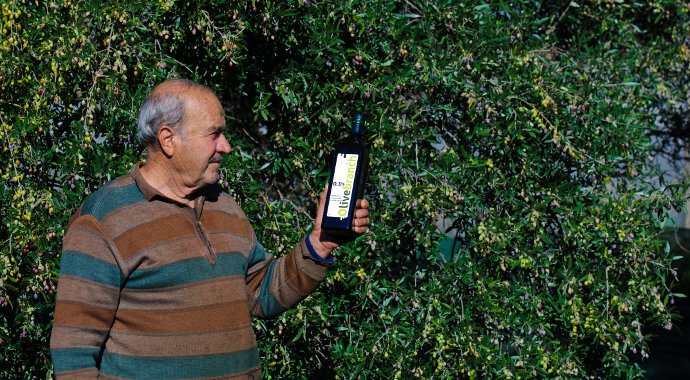So what constitutes good quality tasty olive oil? And for that matter, how is olive oil graded between extra virgin and virgin? Extra virgin is the oil from the first cold pressing of the olives. Cold press is a term widely used in the marketing of olive oil but we must take note that the first cold pressing alone is no guarantee that the oil can be classed as extra virgin. Once the oil is made, producers are legally obliged to measure the ‘acidity’ of the olive oil – this is the volumetric content of acid in the oil. The acidity level will then determine how the oil is classified, whereby oil with an acidity of <0.8% is classed as extra virgin, oil with an acidity of between 0.8% and 2.0% is virgin, whereas all oil with an acidity of >2.0% becomes graded as pomace oil. We at Olive Branch have taken care to produce an olive oil with a significantly lower acidity level of <0.3%.
What is the significance of acidity in olive oil? Acid is produced from the ripening of the olive fruit and whilst the ripening produces a sweeter tasting olive, the ripening process destroys the vitamins and antioxidants in the fruit, meaning that olive oils higher in acidity and particular those in the virgin and pomace category are lower in goodness. Extra virgin olive oil is the best grade of olive oil available, but there are different levels of quality within this category so the best way to determine the quality and more importantly the ‘goodness’ in the olive oil is to look out for a lower acidity level. You will find that lower acidity oils taste fresher and are more full bodied in flavour.
Within the world of olive oil there are many producing countries, including Greece, Spain, Italy and others much further afield such as South Africa and New Zealand. Crete, where our olive oil is made, produces the highest quantity per capita of extra virgin olive oil, so you could say it produces the highest quantity per capita of the more superior olive oil. Having learned that acidity is the key barometer for quality in olive oil, we should also be vigilant that not all Cretan olive oil will automatically be of superior quality since the acidity for extra virgin can be anything below 0.8%. In fact, most of Crete’s extra virgin olive oil remains on the border around the 0.7-0.8% level.
We have gone to great lengths to create an acidity of <0.3%. All of our olives are hand-picked so we can select them at the right stage of growth. They are picked just as they begin to ripen as this is when they have the most amount of goodness. You will notice they have been picked at this stage (often known as the early harvest) by the peppery finish to the taste. Once the olives have been picked, we cold press them within hours, so the olives don’t have a chance to disintegrate or ripen, thereby allowing us to preserve the full freshness and goodness of the olives. We should also point out that our olive groves are located on the foothills of the mountains where the terrain and air is very clean, allowing for great growth for the olives!
We’d like to finish by leaving you with some tasting notes for our olive oil. We recently sent our olive oil to an international judge and expert on olive oil and here is her assessment, following tastings on 3 separate occasions:
Tasting Notes for Olive Branch:
Aroma:
Sharply aromatic aroma of grass and cut herbs with juicy green apples, then some citronella and green bananas with a touch of nuts
Taste:
The taste is less herbaceous with perfumed stone fruit and sweet macademia and almond nuts then the flavour of ripe bananas builds and lasts through the touch of almond skin bitterness and lightly spiky pepper to linger attractively on the after taste with more sweet nuts
Style:
This is quite a delicate style of oil with light but well balanced bitterness and pepper
Assessment:
The complex mixture of aromas and flavours makes for an attractive and interesting oil. It is an all-round oil which could be used effectively in most culinary applications with all but the most pungent ingredients

